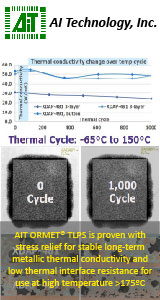|

|
|
| Ask the Experts | |||||||
|
|||||||
|
July 21, 2008 - Updated July 21, 2008 - Originally Posted Solder Paste Inspection During BGA ReworkWhen it comes to BGA rework, where the solder paste gets applied "manually" using a Mini-Stencil, how much sense does it make to use an automatic inspection system to check solder paste height for every BGA that is reworked for every board? R.A. |
|||||||
| Expert Panel Responses | |||||||
|
Sense can mean different things to different people. The criticality of solder paste height increases as the size of the BGA increases. So, for a 600+ I/O BGA, I might answer that knowing solder paste height is important. If the BGA is only 256 I/O, then maybe a simple visual inspection might be sufficient. The risks involved are also critical. How expensive is the BGA or the product? How many times can you rework? Answers to these questions should help you determine if solder paste height inspection is necessary and cost-effective. Note: When I audit EMS providers, I tend to aggressively push for solder height inspection for all products of medium to high complexity.
CEO & Managing Partner DfR Solutions Dr. Hillman's specialties include best practices in Design for Reliability, strategies for transitioning to Pb-free, supplier qualification, passive component technology and printed board failure mechanisms.
Based on the information that you have provided, you are stenciling onto the PCB. In this case you would want to do an inspection of the site as the Micro Stencil can become misaligned, the stencil can be accidently placed onto an adjacent part or the operator can miss-wipe the squeegee causing voids. If you were using a Stencil Print Plate that prints the solder paste onto the solder balls, you would have much higher success rates with your printing applications and not have to tie up your inspection system.
Regional Sales Manager OK International Inc. Ed Zamborsky is a Regional Sales & Technical Support Manager for Thermaltronics, located in New York. His position requires frequent customer visits throughout North America and the Caribbean and his position encompasses not only sales but the role of trainer and master applications engineer for all of Thermaltronics products. His expertise includes such specialties as hand soldering, convection and conduction reflow techniques, array rework, fluid dispensing equipment, and fume extraction. Ed has authored many articles and has presented many papers on topics such as; Low Volume SMT Assembly, Solder Fume Extraction, SMT Rework, BGA Rework, Lead-Free Hand Soldering, High Thermal Demand Hand Soldering, Lead Free Visual Inspection and Lead Free Array Rework.
Seems like a difficult task. There is another option for reworking BGA's and that is to print solder paste on top of the BGA balls (see "BGA and QFN Repair Process" APEX 2008). The stencil gaskets to the balls and gives a very uniform solder volume.
Vice President Technology Photo Stencil For over 18 years, Dr. Coleman has been the vice president of technology for Photo Stencil, working closely with customers to understand their printing requirements. His efforts have resulted in several new stencil products.
|
|||||||
| Submit A Comment | |||||||
|
Comments are reviewed prior to posting. You must include your full name to have your comments posted. We will not post your email address. |
|
Free Newsletter Subscription
Circuitnet is built for professionals who bear the responsibility of looking ahead, imagining the future, and preparing for it. Insert Your Email Address |
|

|





